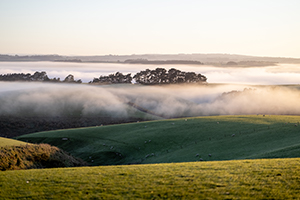
The Fight for the Future of Farming
Meet the farmers who are risking their reputations to save our environment.
By Nicola Harvey
Photo: Hamish Bielski’s Southern Otago farm captured at dawn by Camilla Rutherford.
A rough northerly wind is howling down the Mataroa valley as Bill Coogan flicks the gate latch and gestures towards the hills. “Does this look steep to you?” he asks. The answer is yes. His farm is steep, hard hill country. An hour earlier we’d been eating homemade mini-pies and butter-laden muffins in the warm, weatherboard cottage where Coogan lives with Jennifer, his wife of 51 years, and he told me his farm used to be considered one of the worst in the region. “Probably still is,” he admitted. “You’d call it shit country, actually,” Jennifer replied.
It was spring when I arrived at the Coogans’ immaculate cottage in Mataroa, just west of Taihape in the central North Island. Bill met me at the garage door and waved towards the Covid QR code pinned to the wall. “My son said we had to do it,” he says. “But no one’s really come here other than the fuel man.” Inside, I’m presented with a map of the 1000-acre farm: 600 acres purchased in 1986; another 400 in 1990 for $186,000. “That’s in bush,” Coogan says, pointing to the paddock named 40 Acres on the small satellite map. “That’s in native.”
Coogan was born and raised in this valley, affectionately known as Coogan-ville. (His grandfather arrived here in 1886.) Now 74, Bill has been farming this block for close to 45 years, and each one can be seen in the weather lines on his red-vein-flecked cheeks. Cousins farm either side of the road leading up to his property. Coogan used to think he’d hang on until he reached the 50-year mark, but not anymore. “Yeah, no. I’m basically disillusioned with it,” he says. Disillusioned with what? “Oh, a lot of these regulations and rules that are coming in . . .” Coogan trails off. “I’ll show you the rain charts I have down in the shed,” he says.
Coogan has been telling me about the 300 millimetres of rain they had over a few days in 2004 that started 120 slips on the property. No amount of planting trees and shrubs will stop landslides on steep Taihape sandstone if the rain sets in. Coogan knows this. He’s been farming since he was 18 and he tells me he’s yet to meet a farmer who’s against changing their methods if the results mean improvements for the land and the bottom line. His family, he reminds me, has been innovating for decades in order to keep food on the table. They’ve just been doing it without all the rules.
It is clear to farmers like Coogan that global warming has crawled under the farm gate. Driving the country’s backroads — west to the green-drought of Central Hawke’s Bay, up through the Hauraki Plains past small, tired milking sheds and enormous, hangar-like dairy cow stand-off pads, and into Southland’s fields churned to mud by cattle and sheep — I can see the land is changing. Some of it by design, some via the chaos of nature.
“Unless New Zealand farmers accept that current land use practices are unsustainable, the way ahead will be tortuous.”
In August, the Coogans spent an evening at their local veterinary clinic listening to Otago farmer Jane Smith and Groundswell spokesperson Jamie McFadden, who called on farmers to question the government’s environmental regulations. “I don’t usually enjoy those things,” says Jennifer, but they found Jane Smith entertaining. “Shoots from the hip,” confirms Coogan. Considered a farming leader, Smith has penned searing op-eds criticising the government and accusing Environment Minister David Parker of running a personal crusade against farmers. Yet she also describes herself as an “environmentalist through and through”, advocating for localised collective action to improve freshwater rather than one-size-fits all national regulations. As I was to discover, many farmers don’t consider this a remotely contradictory position.
New Zealand’s farming sector is typically portrayed as a monolith. While the rural workforce — labourers, contract milkers, fencers, pickers, shepherds — vary in age and ethnicity, the farmers, those who own the land or make the decisions, share a deep-rooted common identity. The vast majority are Pākehā men over 45 years of age. Historically, they’ve succeeded as family-run businesses by banding together with their mates to export their products collectively.
Many New Zealanders see this group as the primary obstacle to the government’s attempts to introduce lasting environmental reforms that will ensure the country lives up to its clean green reputation. But in my travels I found a much more complex situation. All over rural New Zealand, questions about how farming impacts the environment are creating fractures in families and communities. The traditional decision-makers who have long guided the family farm are having their beliefs and practices challenged by regulators and politicians, city-dwelling vegan friends and — perhaps most profoundly — their own children, who are returning to land they will one day inherit with new ideas moulded by urban environmentalism. And many aren’t happy about it. As one young female farmer told me, “There is a lot of ego in farming.” The frustration of the traditionalists is heard in the loud voices from the Groundswell protests calling to halt freshwater regulations and pump the brakes on climate change mitigation.
At the other end of the spectrum, there’s a vanguard of progressive farmers who have been taking huge personal and financial risks to change their systems, hoping to secure an ecologically robust future and find new business opportunities with consumers looking for sustainable products. In between is a mass oscillating between action and inertia. They aren’t on social media or in the headlines. They’re the ones on the land, following the seasons, the soil, the stock, and they absorb every public condemnation as a bruise. Quietly they are changing the way they do things through trial and gut instinct. And the choices they make in the very near future could determine whether or not we’ll be truly able to solve our environmental problems.
Water, Aotearoa New Zealand’s collective taonga, is how we’ll experience the impacts of global warming. Through floods and drought, mostly. The consequences of the 1.1-degree-Celsius surface temperature bump present as heat waves, increasing frequency of heavy rain, storms that are more violent, more prolonged droughts, and floods caused by overrun river systems that reclaim centuries-old pathways through prime farmland, like those that occurred in Canterbury in May.
The health of our water is also one of our most urgent environmental challenges. Almost all of New Zealand’s rivers contain pollutants that are in small and dramatic ways changing the ecosystem. Two thirds of the 1500 river sites monitored by Land, Air, Water Aotearoa (LAWA) show high traces of E. coli. Sediment, nutrients, chemicals and waste are washing into our freshwater from cities, industry and farms alike. And much of this contamination is entirely preventable.
In September 2020, the government’s National Environmental Standards for Freshwater came into force, aiming to halt lasting damage to the country’s 425,000 kilometres of riverways and almost 4000 lakes. It requires farmers to plant riparian strips around wetlands and streams and fence off waterways from cattle, sheep and deer. Additional measures have been mooted and rolled back, often following complaints from farmers that the rules are unworkable in practice. Andrew Morrison, chair of Beef + Lamb New Zealand, is adamant that farmers can achieve environmental targets if they’re given flexibility. “Tell us what you want to achieve,” he asks of the regulators, “and then leave us to sort it out and we’ll achieve it for you.”
The Labour government’s planned climate change measures are similarly contentious. Since 2016, New Zealand’s Paris Agreement pledge has been to reduce emissions by 30 per cent below 2005 levels by 2030, and to hit zero carbon by 2050. Ahead of the United Nations climate conference in Glasgow, the Labour government announced an even more ambitious target of 50 per cent. It also signed on to an initiative to cut global methane emissions by 30 per cent. However, the agreement does not actually require New Zealand to go beyond its existing commitment of a 10 per cent reduction.
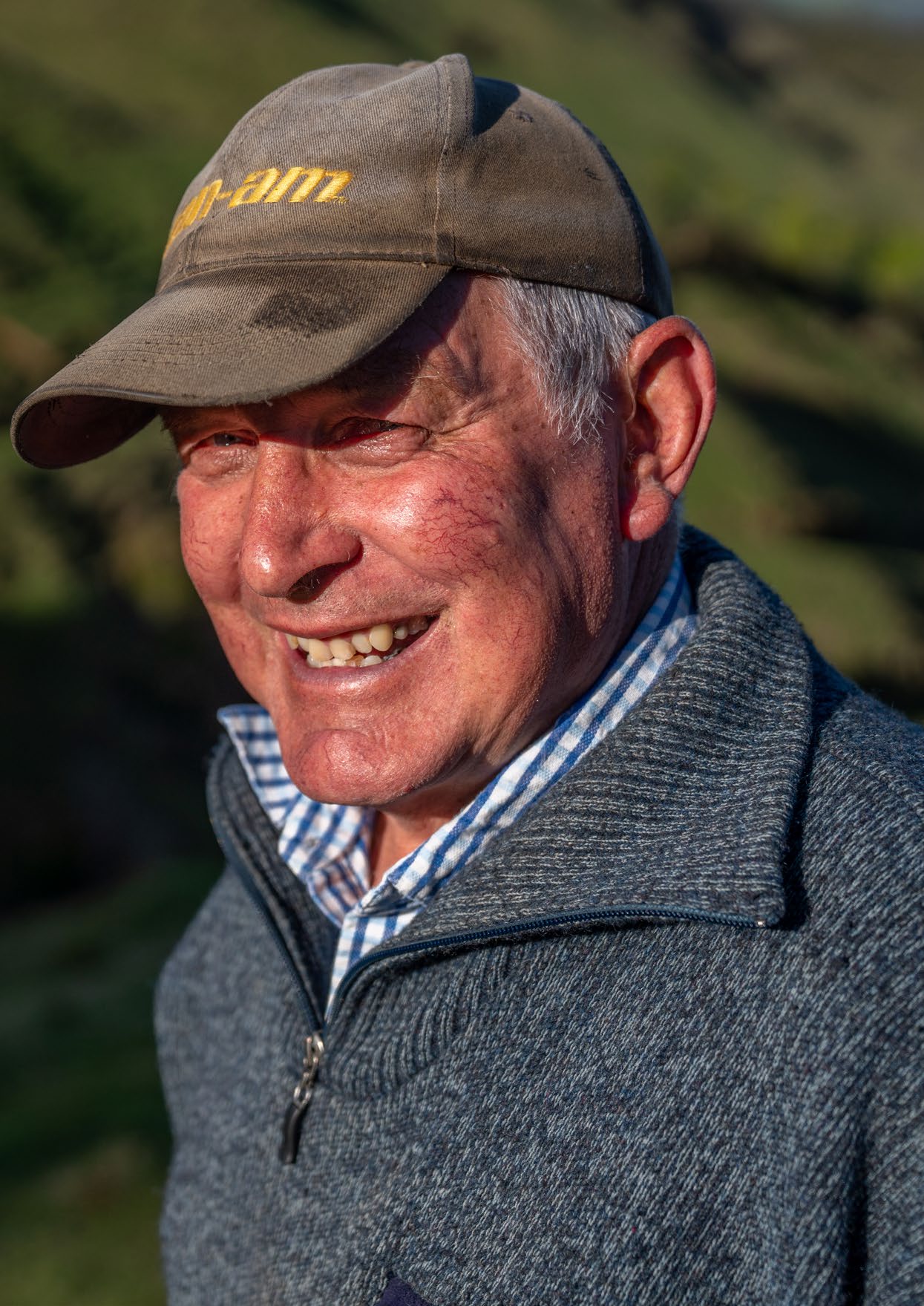
Bill Coogan. Photo: Richard Brimer.
New Zealand is unusual among developed nations because almost half of our gross emissions come from the methane-heavy agriculture sector. Under global agreements, biogenic methane is calculated as a carbon equivalent, even though the two gases behave very differently. Since methane only exists in the atmosphere for 12 years, reducing emissions can actually cause cooling. Because carbon dioxide lasts around 1000 years, the fossil fuels we burn keep accumulating. And so while climate scientists agree that carbon cuts are ultimately the most important, reducing methane is a potent tool for fighting rising temperatures in the immediate future.
Professor David Frame, director of the New Zealand Climate Change Research Institute and a lead author of the fifth assessment report of the Intergovernmental Panel on Climate Change (IPCC), has long advocated for treating carbon and methane emissions separately. He believes there’s a touch of neocolonialism embedded within the climate science fraternity. The international conversation is dominated by industrialised communities “for whom agriculture is a heavily subsidised nice to have”, he says. So their focus is on cutting methane emissions, because ending fossil fuel use is seen as too hard.
Under He Waka Eke Noa, a collaborative programme between the primary sector, the Crown and the Federation of Māori Authorities, the majority of farmers must develop plans for measuring and reducing their emissions. If the sector fails to meet milestones by June 2022, the government can roll agriculture into the national emissions trading scheme, removing the option of offsetting emissions through on-farm tree planting.
In September, I spoke with Federated Farmers president Andrew Hoggard, who represents almost 13,000 “mum and dad” farmers across the country, half of whom are dairy operators. Federated Farmers has also urged United Nations climate negotiators to devise different targets for methane and carbon. (Before the Glasgow conference, Minister of Climate Change James Shaw told me the government didn’t intend to push for an alternative metric. “There would be almost no appetite internationally to re-open this negotiation,” he says.)
There is concern among farming leadership that without unique pathways for the two greenhouse gases, the focus will remain on planting trees to offset for carbon emissions, eating up increasing amounts of agricultural land and threatening the food and fibre sector’s 47.5 billion export revenue. That’s why Hoggard and his peers are advocating for new technology like methane-reducing feed supplements as a possible tool for reducing farm emissions quickly. But it’s a solution being developed primarily for dairy cows fed in sheds and cattle housed in feedlots — not the free-range grazing cattle and sheep that are the backbone of New Zealand’s meat and wool sector.
This vision, that technology will lead farming through climate change, is worrying for Emeritus Professor Frank Griffin, the director of Otago University’s agriculture research unit. He’s concerned that the relentless pursuit of improved production will shoot New Zealand farming straight past the land’s natural environmental limits. “Unless New Zealand farmers accept that current land use practices are unsustainable, the way ahead will be tortuous,” he says.
It was late spring in Otago but it felt like winter. Forty minutes of light snowfall as I headed south from Queenstown airport; driving rain as I passed through Gore followed by 10 minutes of sunshine. Then, as I pulled off the Clinton Highway, the drizzle started.
At the Westridge farm house, Mark and Madeline Anderson had just come in from a morning’s work feeding calves. With only 30 out of 660 cows left to calve, the season was nearing its end. We settled at the kitchen table with a cup of tea. Mark grew up in this house with its wood veneer panelling and 1980s kitchen. The farm was a sheep property back then, but his parents took a risk and converted to dairy years before the Southland conversion boom.
Mark left school at 17 and started working on the farm soon after, helping his father and uncle “wing it” through the first couple of tough seasons. As the money started to flow, the family converted Mark’s grandfather’s farm from sheep to dairy, too. That’s where Mark and Madeline first made a home together. The family sold the property just before the 2014–15 dairy bust, when milk prices fell through the floor. Now, the industry is at a peak again, motivating some to produce as much milk as possible while prices are good.
A couple of years ago, Mark, 43, and Madeline, 37, started shifting from conventional to regenerative practices. Simple things, like “keep the soil covered” and “ensure plant roots stay in place”. Since 2016 they’ve slowly dropped their herd from 850 to 660 cows, planted thousands of trees, cut out synthetic fertiliser and converted a high-input cropping block adjacent to the original family farm into perennial pastures that act as carbon sinks.
The change in approach wasn’t well received by Mark’s parents, who are now retired but remain co-owners of the farm. “I think they probably see that there was nothing wrong with the previous system,” Mark says. “If it ain’t broke . . .” He pauses to choose his words carefully. Madeline says pointedly that their ambitions have diverged from Mark’s parents’. Where profit may have been the driver in previous years, Mark and Madeline are focused on future-proofing the land, plus their collective health and contentment.
Over time, this placed significant strain on the family’s relationship. Similar conversations are happening on many family-owned farms in New Zealand, and they become especially fraught when the focus is on succession. Decisions affecting productivity can have major financial implications for multiple generations of a farming family (the median price per hectare for dairy land, for instance, is about three times that of grazing land). The tension with his parents has weighed heavily on Mark, and sometimes he’s found himself wondering if it would be easier for him and Madeline to sell up and start a little permaculture farm on their own. At the same time, he feels a deep obligation to the farm he grew up on.
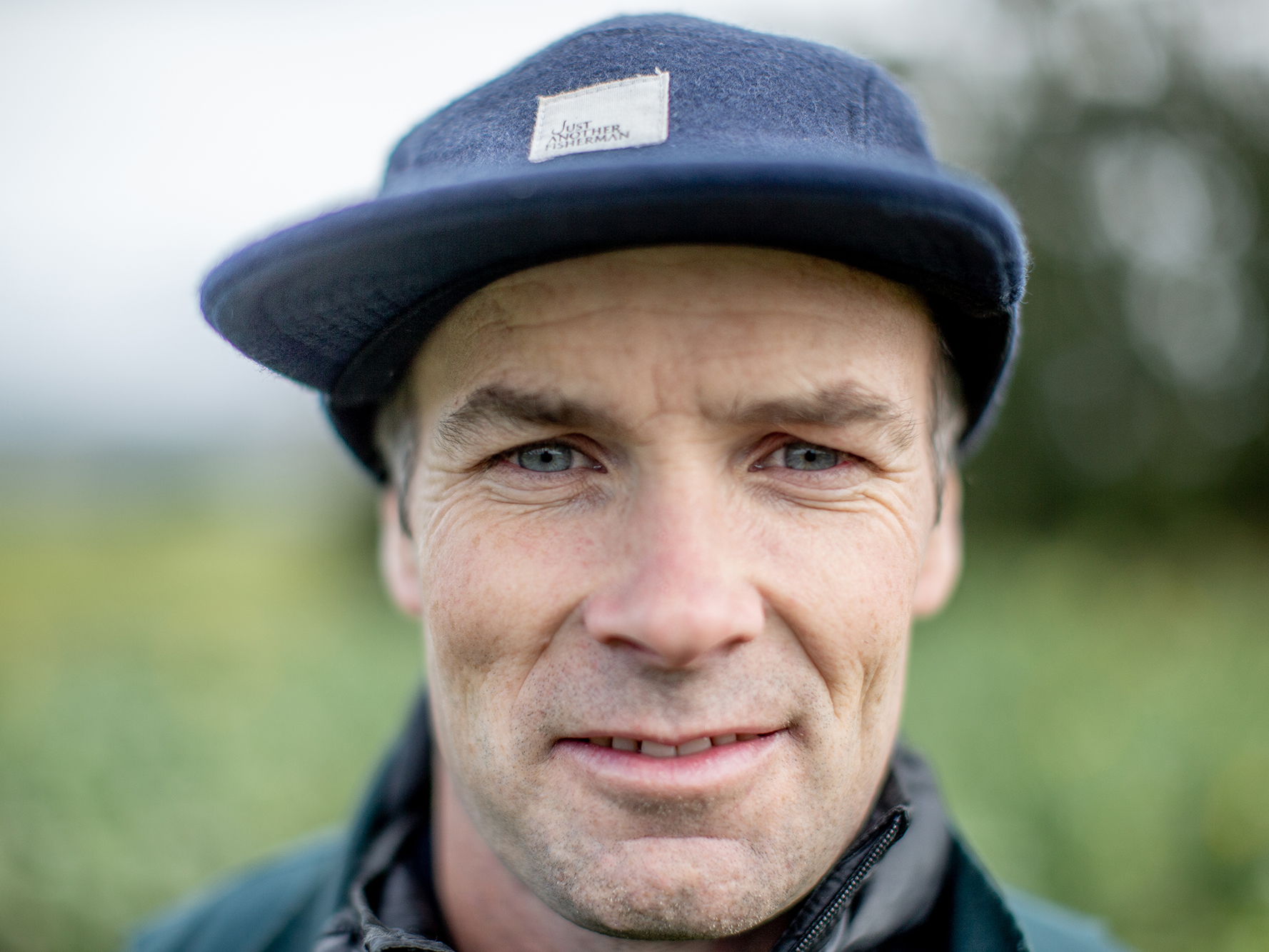
Mark Anderson. Photo: Camilla Rutherford.
For Madeline and Mark, the value of that land cannot be rendered with a dollar sign. “The land has been seen as something that you just take from,” Mark explains in reference to his parents’ priorities. “But I don’t see it that way.” (Mark’s father Tony Anderson declined to be interviewed for this article.)
Westridge dairy farm looks different to the neighbouring properties. The paddocks are full of robust plants; the grasses and herbage are deep green and voluminous. Round spots of tan dot the landscape where hay bales once sat and grass will sprout when the weather warms. There’s no exposed muddy paddocks where weeks earlier cows would have grazed on yellow-flowered brassicas strip by strip. Mark proudly points out half a dozen long, tall rows of compost, which contain the waste from the calf sheds and calving pad. Once broken down, the compost will be spread on poorly performing paddocks instead of fertiliser.
The Andersons regularly host researchers from Manaaki Whenua and Otago University; the farm has become a patchwork of experiments to figure out how to farm dairy cows productively and without chemical fertiliser, to replenish the land and produce nutritional food.
I ask them if a cultural shift is occurring across generations in farming because of environmental change and Madeline answers promptly: “Yes.” Mark is more circumspect. “The awareness is increasing,” he says, but “it feels like we’re starting at the bottom.” They’re hopeful, but the climb ahead is steep.
Mark explains the main argument he hears from conventional farmers: “If I change my system, going away from fertilisers and things like that, then I’m doing a disservice to all these people that I’m employing.” In other words, farmers worry production will drop, and less production means less cash.
But Madeline has noticed the farming sector sag under the weight of mental ill health, which comes with a cost of its own. “This regenerative thing,” she says, “it’s got a totally different spin on it.” Mark agrees: “I think what gets people about this is that it is positive, and we’re so used to . . .” He pauses, and the couple both talk at once. “Negative,” says Madeline. “Angry,” says Mark.
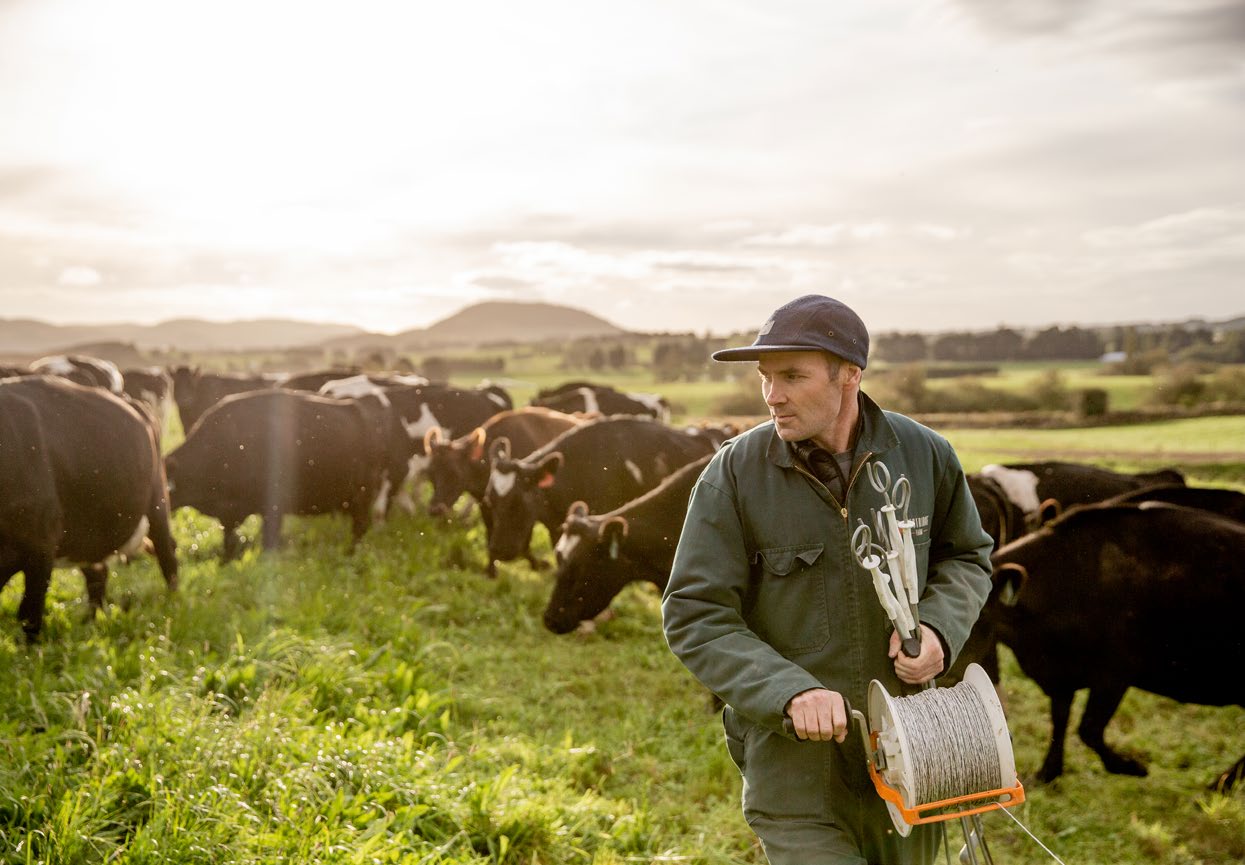
Mark Anderson fencing off the cows. Photo: Camilla Rutherford.
The southern tip of New Zealand breeds loud voices, be they protesting, lobbying or futurising. On the way to Westridge I passed the turn-off to Waikaka, a picturesque corner of Southland where one of the founders of the Groundswell movement, Laurie Paterson, farms with his family. More than 30,000 people follow the Groundswell Facebook page. Many of them turned out in July when the group staged nation-wide protests against the government’s freshwater regulations, electric vehicle initiatives, and the so-called “land grabs” (a reference to local council mapping of ‘significant natural areas’ on private land under the Resource Management Act). There have been calls for the founders to start a political party. Some Groundswell followers have attacked the vaccine rollout as just more government overreach: co-founder Bryce McKenzie declined to appear in an advertising campaign encouraging rural communities to get vaccinated. He told me he has had his first jab, but did not want to participate in the campaign because he believed vaccines had become a political issue that is “tearing families apart”.
Paterson and McKenzie say that they aren’t against regulations, they just don’t like “unworkable” ones. But the group’s message about individual rights has made it a magnet for those who resent the Labour government, specifically Prime Minister Jacinda Ardern. The sight of hundreds of tractors and utes rolling into small towns bearing signs that screamed “Jacinda is a Communist bitch”, “Free NZ from bitch rule” and “Cindy=Stalin” revealed the anger brewing deep within some communities, not just farming ones. Paterson told me he’s been taken aback by some of the “crazy” sentiment expressed on the group’s public forums. Another protest is planned for 21 November.
The day of the July protests, I was in Taupō as 50-odd tractors rolled in from Reporoa. A southerly wind was blowing across the lake, turning many a protester’s cheeks fiery red. I asked one woman sitting in a black Dodge Ram truck why she was joining the 200 or so protestors. She pulled out her phone and found an apocryphal quote often attributed to Thomas Jefferson, a founding father and early president of the United States: “When the people fear the government, that’s tyranny; when the government fears the people, that’s freedom.” Her son Hori sat in the driver’s seat. He has land near Taupō and interests in kiwifruit and forestry, and was there to protest the “land grabs”. In the background National MP Louise Upston was working the crowd.
Another couple, Jac and Simon, told me the regulations felt like “death by a thousand cuts”. The value of their land has dropped because it sits within a catchment area that limits land and nitrogen use under the Waikato Regional Council’s cap-and-trade programme. The only thing that will return their asset to its former value is to break it up into parcels for lifestyle blocks — that is, to quit farming. Jac is resolute that’s the last resort. “We are not trying to stop environmental improvements,” she says. “But they need to be equitable, fair and practical.” We were interrupted by an elderly man handing out bumper stickers from a little bum bag. “Will you put this on your truck?” he asked Jac and Simon. The sticker read “Jacinda, Get Out Of My Life”. Simon accepted it and rolled it uncertainly in his palm.
A few years ago, Hamish Bielski, who also farms in vocal southern Otago, started talking passionately about the changes he was making on his farm. He’d come up through the ranks as a shepherd and stock manager, but a conversation with a soil scientist at a farming workshop led him to question the methods he’d been taught. Bielski, 45, started experimenting on the farm he co-owns with equity partners. “I was excited,” he says. “We were improving our soils, our pastures, our stock, our bird life, our whole ecosystem.”
The first few seasons were chaotic. Hamish and his wife and business partner, Amy, started cutting back on fertiliser, combining stock into large mobs and moving them sometimes multiple times a day to spread the natural manure evenly across the paddocks. “[We] got hit with very cruel blows that just about sink ya,” Bielski recalls. “I was very naive.” He reckons his learning curve perfectly mirrors the Dunning-Kruger effect: early confidence followed by the valley of despair as you realise your limitations, then the slow climb up to enlightenment and on to stability, which is where he’s at now.
One of the core regenerative principles is to know your context. Good farmers, I’ve learned, rail against a onesize- fits-all approach regardless of where they sit on the farming spectrum. He Waka Eke Noa, which translates to “we’re all in this together”, is essentially a regulatory template. Farmers like Bielski, who are passionate about reducing their carbon footprint and improving water quality, struggle to square the bureaucratic box-ticking with their specific ecological needs.
For instance, Bielski is frustrated with He Waka Eke Noa because in his view it doesn’t reward farms working to decarbonise. Instead, he says, it centres on the government’s ambition to make major cuts to biogenic methane mostly via reductions of cattle and sheep. I try to keep up as he starts talking about plant biology and carbon cycles.
“They don’t want to be called new age. That’s the one thing Kiwi males don’t want to be.”
He explains the issue like this: plants need carbon dioxide to grow. They draw it from the atmosphere through photosynthesis. Cattle eat the plants, then belch methane as they digest them. Methane lingers in the atmosphere before converting back to carbon dioxide for plants to absorb. So, if a farm maintains a sustainable number of cattle, the methane is being constantly recycled as long as enough plants are in place to preserve the carbon cycle. It’s not the cows themselves that are the problem, Bielski reasons. It’s how we’re farming them. His approach would effectively mean fewer cows and lower methane emissions, too — but the entire farming operation would also become less harmful.
Professor Griffin has followed Bielski’s work. He too advocates for a paradigm shift. The majority of conventional cattle farmers follow a heavy cropping cycle — buying seeds, fertiliser, fuel, then more seeds, fertiliser and fuel to grow winter feed crops and new grass in succession. Under a permanent pasture system, farmers would sew in a base of grasses and herbage, then let the seed bank existent in the soil flourish for stock to graze. No cropping means less fossil fuel and fertiliser, and carbon sequestered in the soil stays intact. Yet for the entire industry to change, Bielski reckons, it’ll take 20 years.
“My problem is I go too fast,” he says. Bielski is proving that one can farm in southern Otago with little to no synthetic nitrogen in a manner that protects the ecosystem. But his methods are pushing up against decades of entrenched farming practice — and the public’s alignment of nitrogen with pollution is inflaming a culture of defensiveness He has run up against senior agriculture researchers such as Lincoln University’s Professor Derrick Moot who has said regenerative practices are scientifically untenable, bordering on mythology. According to Moot, the science proves that New Zealand soil needs fertiliser.
A couple of years ago, Hamish and Amy started to notice a shift in their social interactions in their small Balclutha community — a sense of cooling. Hamish stopped doing social media. And he no longer refers to himself as a regenerative farmer, “because that’s implying that I’m doing something better than my neighbour,” he says. “Ideology is very off-putting.” But he doesn’t see himself as an idealogue. “I just want to reach the potential of life,” he says. “And life covers everything. My wife, my family, your soil, your plants, your animals, it’s all life. I just like to challenge the status quo.”
Griffin believes Bielski and others have provided a pathway and many farmers are trialling changes “in the back paddock”. They’re just not talking about it. “They don’t want to be called new age,” says Griffin. “That’s the one thing Kiwi males don’t want to be.”
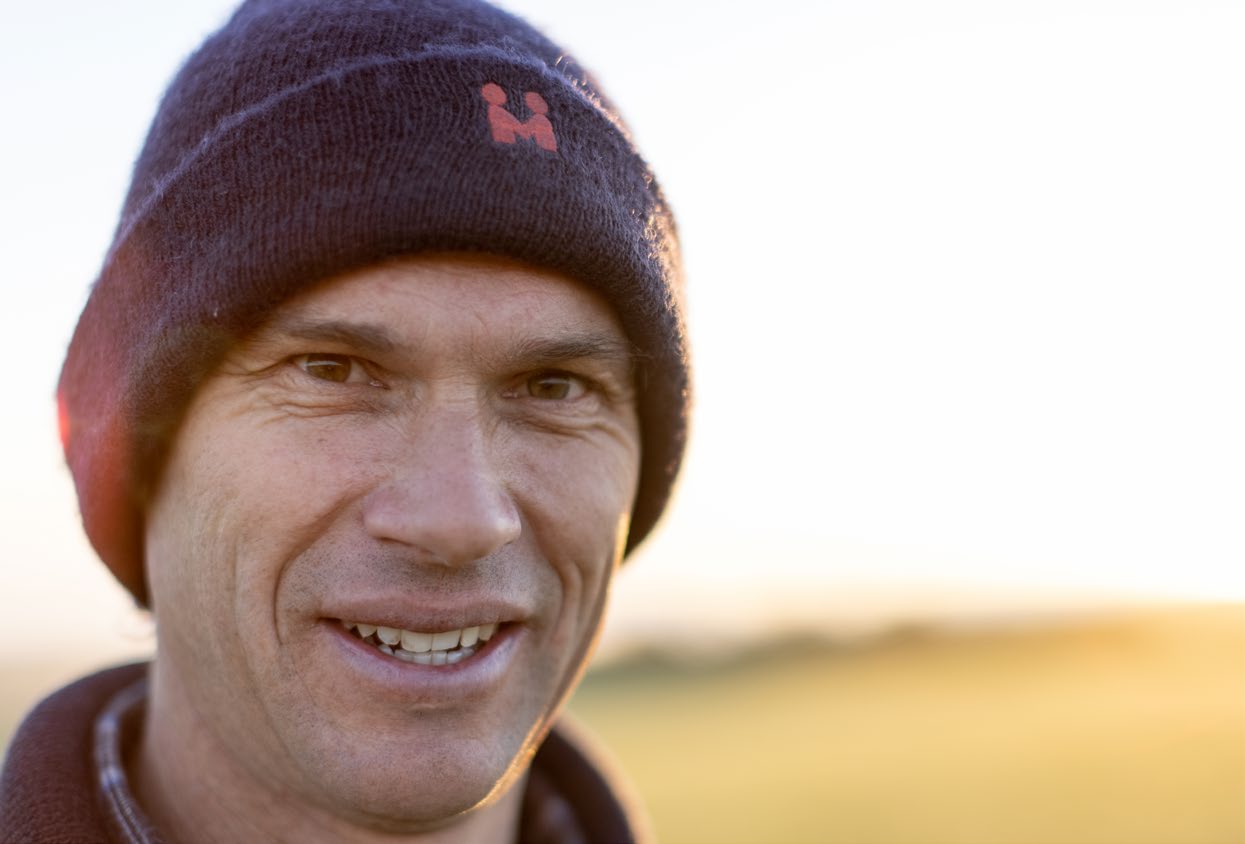
Hamish Bielski. Photo: Camilla Rutherford
At the top of the Coogan farm, I followed Bill to a cliff face and looked over the edge. Wind-blown tears ran from the crinkled corners of his pale blue eyes. A faded Can-Am quad bike cap pulled down tight over his greying hair and a collared wool jumper flipped up around his ears did little to dampen the wind chill. New age, he is not. Coogan is conventional to the core.
Halfway down the steep slope a Perendale ewe had just given birth to a yellow-tinged lamb on a small precipice partially hidden by a scraggly shrub. A trail of bloody mucus still dripping down its rear leg, the ewe licked the tiny animal, ignoring us far above. “It used to scare me a little,” said Coogan, about the steepness. But it’s dead easy now. According to the Coogan guide to productive hill country farming, you’ve got to have common sense (“not much of that left anymore,” he says, gesturing to the world around him) and control what you can grow naturally, whether it be mānuka scrub, or rye, clover, cocksfoot and timothy grass. Plus a bit of superphosphate.
Since the 1970s, if the budget allowed, Coogan would hire a topdressing plane to drop tonnes of fertiliser on his farm. A short-term nutrient bump can occur in the soil after the land is cleared via burning — a practice Coogan once embraced to rid his farm of mānuka. But it doesn’t last long. Coogan’s son Jarred, 49, remembers days when the sky glowed orange from the backburning. There’s no hillside fires now, Coogan assured me when he noticed my eyebrow rise. But back then, he explains, the government encouraged it.
For centuries farmers have used natural fertilisers like bird droppings, manure, seaweed and remnants of decomposed animals to add nutrients back into the soil to help crops and grasses grow. Plants need nutrients to thrive and nitrogen and phosphorus are chief among them. Access to nitrogen became easier in the 20th century with the invention of the Haber-Bosch process, a breathtaking innovation that saw manufactured materials used to make explosives for World War I repurposed as fertiliser. But if the combination of synthetic nitrogen fertiliser and nitrogen excreted by animals via urine and manure exceeds plants’ needs, it becomes a problem. Nitrates can leach through porous soil over decades, ending up in aquifers and ground wells, or simply run off with excess water and sediment into the nearest stream. Once there, in combination with phosphorus, the water environment becomes ripe for algae blooms and other subtle ecological changes result.
In drinking water wells, nitrates pose an even greater risk: at high levels the water becomes unsafe to drink for bottle-fed babies especially. LAWA reports that only a small number of river-monitoring sites show toxic levels of nitrates, but ground well clusters in agricultural areas such as Ashburton have in recent years shown levels of nitrates above the limit required for safe drinking. In this setting nitrate-nitrogen becomes a synonym for pollution. On the farm, though, the application of fertiliser simply means more profit.
Jarred reckons his father’s generation struggles with environmental rhetoric because it’s heard as a “kick in the guts”.
Once a mob of ewes on marginal land like the Coogans’ may have had 90 lambs to every 100 sheep. Now that same mob will produce 150 in a good year, mostly because they have more grass to eat. Those 150 lambs, destined for the United Kingdom or the Middle East, are sent to the meatworks at a weight far heavier than 50 years ago. More feed means more food for consumers in overseas markets which in turn increases farmers’ earnings and pushes more money back into the local economy. The fear buried in the criticism of Hamish Bielski’s low-input farming methods is that without nitrogen, profit margins plunge. But Bill Coogan, who farms both sheep and cattle, has an old-fashioned farming phrase he lives by: “Be careful about buying production.”
I’ve read that some farmers privately discuss the difference between a good farmer and a successful farmer. The former works within the limits nature has set out, which comes from learning from the “old fellas behind ya”, as Bill Coogan describes it. “And learning from your mistakes,” Jennifer elaborates. Today a lot of good farmers are already working for the same environmental ends as the government — they’re just doing it without the paperwork. The latter, however, are farming to push the limits of nature as far as they bend in the name of profit and productivity, hoping all the while the system doesn’t crash. Most farmers can easily spot the difference, but they don’t criticise each other. At least not publicly.
Jarred reckons his father’s generation struggles with the environmental rhetoric because it’s heard as a “kick in the guts”. It’s a story I’ve heard elsewhere. The older generation put in the punishing hours, made the sacrifices, weathered years of financial stress to build up the farm. Then the younger generation take over and claim environmental improvements must take priority. It sounds like an accusation that the decades of hard work were for nothing, Jarred says, “because the waterways haven’t been fenced off”.
Bill and Jennifer semi-retired in July this year. They can no longer see a place for their style of “old-fashioned” farming. Bill is the type of good conventional farmer meat exporters profile when marketing their products abroad as “free-range lamb”. Work with mother nature and follow the rainfall and the grass curve so you don’t have to buy in feed — these are his farming tips. He points out that he wouldn’t have lasted 45 years and still be cupping mouthfuls of water from the river behind his house if his methods were unsustainable.
The rules, he reckons, are too rigid. If the government’s proposals for protecting freshwater from stock come into force, for instance, Coogan would be faced with a perplexing fencing conundrum. His farm hits 800 metres at its highest point and is a network of thin, steep ridges and valleys. In one paddock, under 500 metres he would have to fence off the creek and freshwater springs to keep his cattle out, over that height he would not. It makes no sense, he says.
Jarred Coogan runs a sheep and cattle property in Taranaki with his wife Sarah and her parents. They’ve won environmental awards for their farm work. He can sympathise with his dad’s disillusionment. “In my dad and my father-in-law’s time, it was the black singlet, shorts, gumboots type of fella, working hard,” he says. “But now, you’ve also got to be on to it in terms of animal production, your soils, your fertiliser, the technology in terms of compliance, and consumer demands. It’s a lot more than just a hard-working man of the land.”
Jarred’s concern is regulatory compliance has become the sole focus of farming discussions. “All we’re worried about is getting to 2050,” Jarred explains. “But what happens beyond 2050? All we’re driving towards is offsetting. What about actually reducing emissions? We can all offset and carry on doing what we’re doing but that will come at a price. And that price will be New Zealand’s export earnings, and then how do we pay the bills?”
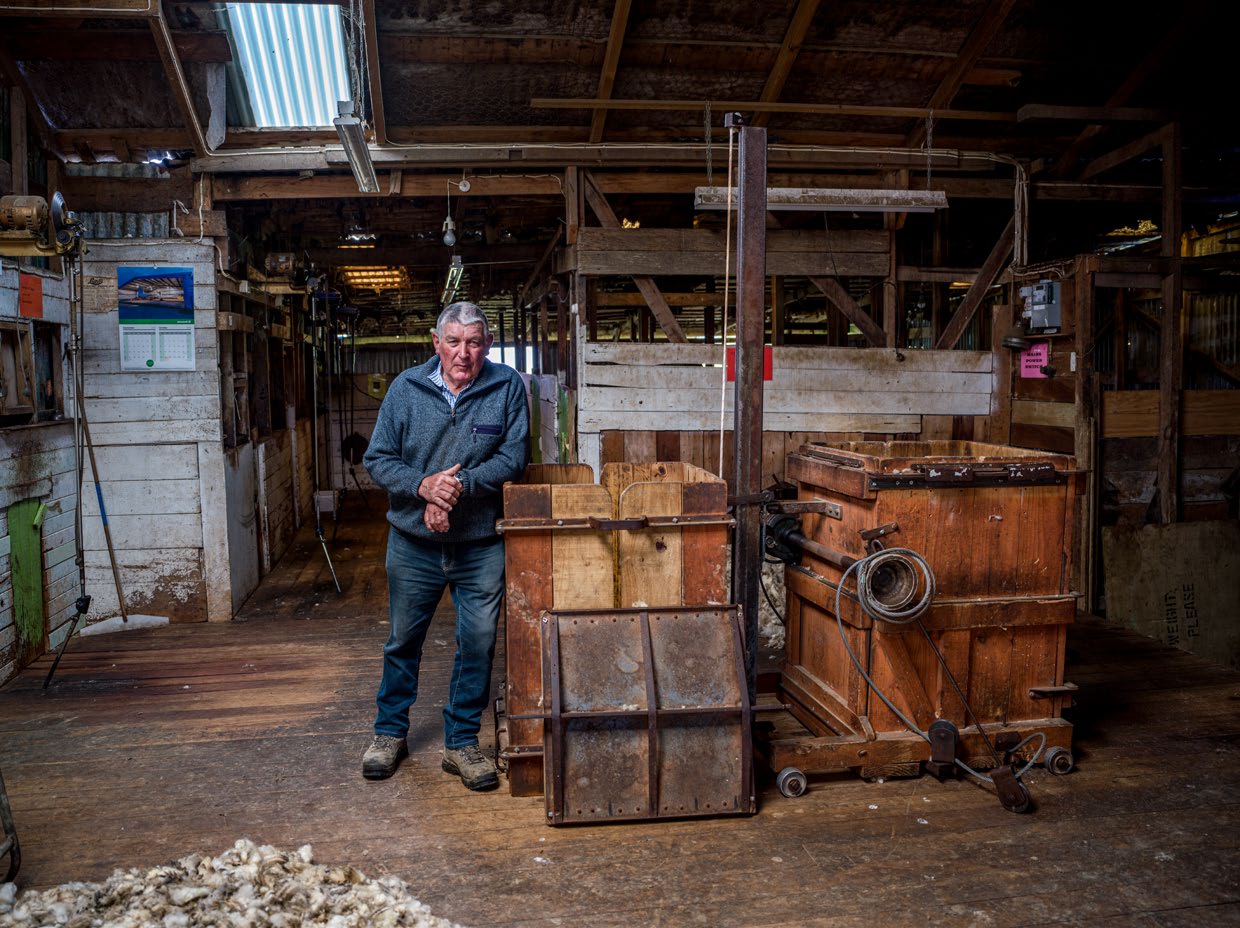
Bill Coogan in his woolshed. Photo: Richard Brimer.
Back in the 1970’s of a lot of hard North Island hill country farmland was cleared of scrub with the aid of grants issued by Robert Muldoon’s National government. Britain had just joined the European Union, ending a long-standing colonial trade relationship that positioned New Zealand as Britain’s ‘farm in the South Pacific’ and Muldoon was trying to keep farmers afloat. But the annual $1 billion subsidy bill far outweighed export earnings; it was political largesse leading to economic disaster. In 1984, David Lange’s Labour government ushered in an era of neoliberal reforms that saw successive governments promote a free-market approach to farming. Sector leaders have embraced the mantra that New Zealand farming is a totem of innovation, efficiency and productivity.
A few months before the freshwater regulations came into force, the Labour government announced a plan to increase primary sector export earnings by $44 billion through a focus on “creating value”. The idea is for New Zealand to live up to its environmental ambitions and command higher prices for its products from so-called conscious consumers. The government wants to see red meat and dairy follow the lead of niche exports like Zespri kiwifruit and produce patented or luxury products, coveted in the global marketplace. And to do it all without taking the foot off the productivity accelerator.
But history and IPCC data shows that constant productivity in pursuit of profit is not always best for the land. The desire to produce more from a piece of land has driven the trend of intensification across all areas of New Zealand farming, but it’s most apparent in dairy. To farm more cows per hectare, farmers have leant on three main tools: irrigation for constant water, energy to drive the irrigators, fertiliser to grow the grass. Between 2002 and 2019 the amount of land under irrigation almost doubled, from 384,000 to 735,000 hectares. A large portion of this was in Canterbury but also in dry areas such as Central Hawke’s Bay and Otago. Fertiliser use shows a similar pattern: by 2016 the overall average use of nitrogen for dairy farms was 126 kilograms per hectare, up from 40 in the late 1990s.
Back in 2004, Dr Morgan Williams, then Parliamentary Commissioner for the Environment, urged the agriculture sector to pull back from intensification in favour of more sustainable systems. He saw the trend as a real threat to the natural capital of New Zealand. Yet resistance to this idea has proved tough to overcome.
To understand why, Williams suggested I look at the entire food production system to understand the risks that farmers shoulder. Some risk is manageable, but increasingly the collective pressures of a changing climate and markets demand farmers completely change how they farm. It’s a leap many aren’t willing to take on top of everything else. “The rural community at its heart has a very conservative base. That’s not a criticism, it’s just a characteristic,” says Williams. In November 2020, the Reserve Bank expressed concern that some 11 per cent of dairy farm bank loans were either in default or stressed. They noted that these farms were reliant on the high milk price “just to remain operational”. In Williams’ experience, a farm is much more resilient — both ecologically and economically — when farmers put aside the relentless pursuit of productivity and appreciate the value of “enoughness”.
“When has it ever been the Kiwi psyche to duck and weave at the back of the pack?”
In Waipukurau, I met Ben Anderson and Amanda Langley, two farmers who are trying to urge others to shoulder the risk of change. In their pre-farming life, the couple served as peacekeepers in East Timor and did stints in the private sector in Saudi Arabia, Sydney and London before settling in Hawke’s Bay. In 2018, Ben told me, he was “pissed off in the office one day” and convinced Amanda to check out a 135-hectare deer farm near the Ruahine ranges. They put in an offer and it was accepted. It was, Ben says, a purely emotional decision.
Anderson and Langley joke that they’re making up for the lack of due diligence when buying the farm by analysing every inch of the primary-sector supply chain, strategising sustainable solutions. Horizon scanning is a technique Anderson learned as a risk specialist. As he looks across the horizon now, all he sees is obstacle after obstacle. Global consumers are demanding environmentally sound products. The next generation are demanding environmental action. Anderson believes farmers have an ethical responsibility in the age of climate change, but accepts that whether to adopt environmentally sound practices is primarily a business decision for many. “I feel like we are in this pivotal stage of fear of change,” Langley told me.
That fear will fade if it can be demonstrated that there’s a stable market for “pasture-fed”, “regenerative” or “carbon-zero” products. Anderson is exploring these markets as part of a Nuffield farming scholarship, hoping his research will help farmers make the leap. “When has it ever been the Kiwi psyche to duck and weave at the back of the pack?” he asks.
Dominic Otimi knows well the hills that flank Lake Taupō’s Western Bay, separating it from the King Country. He is the chair of the committee that oversees the 1100-hectare Whakarawa Trust farm, located in Ngāti Tūwharetoa’s rohe. Where once he hunted for pigs, he now takes his 16-year-old mokopuna to gather pikopiko, a seasonal bush delicacy. For Otimi, and his cousin and fellow farm director Wiari Rauhina, the land they farm has always been a pataka, a source of food and sustenance economically and metaphorically.
On occasion, the farm might be called on to provide a mutton or pig for a tangihanga. But the sustenance is also in the creation of profit and opportunity for the 300 owners. “Anything we do on the farm is about 15 millimetres above ground level. That’s where we have to make our money,” says Rauhina.
Rauhina is also a trustee for a dairy farm near Rotorua, Parekarangi Trust. Its chairman, James Warbrick, explains to me that they must balance nurturing the land with maximising profit because the benefits of success are vast: education scholarships, training initiatives, rehabilitation programmes for rangatahi, housing opportunities, food security . . . the list goes on.
Whakarawa and Parekarangi are just two of the 5000 or so trusts that manage some 750,000 hectares of freehold Māori agriculture land. Each has a few hundred shareholders — individuals, families and whānau trusts that whakapapa back to the land.
Rauhina and Otimi tell me that the Crown has been trying to claw at the Whakarawa land for decades, first by dictating in the 1950s under the Maori Affairs Act that “unproductive” land (defined in European terms) be developed for farming. When banks refused the old people development loans to do this, families funded the breaking in of the land by milling the tree blocks. Most recently, the local council’s attempt to designate the spectacular Karangahape point that juts out over Western Bay a significant natural area (SNA) under the Resource Management Act was met with a resounding no. “Wiari saw it as another land grab,” Otimi said. “Nothing will change,” Rauhina says, thumping his fist on the table in mock outrage and sending the cake plates clattering.
It is over SNAs that Ruahina and Otimi’s criticism of government regulation overlaps with that of many Pakeha farmers. But in regard to freshwater reforms, they are philosophically ahead of the regulators. The ambition is clean water all the way through the farm and on to the ocean.
The Whakarawa Trust farms cattle and sheep profitably, and they do it within a catchment area which is governed by the Waikato nitrogen cap-and-trade programme. Otimi says they have no problem working within this system because it aligns with the way their koros farmed. They draw on scientific research and weigh that against their way of knowing the land. “We have a science that we’ve never let go,” says Otimi, “so we say thank you for what you give, now we’ll look at the integrity of that next to our integrity.” In the summer, he tells me, the hot wind off Lake Taupō can dry the pumice soil in the western shore and create isolated drought zones. Otimi and the old people before him knew this well. They had seasonal “country estates”, as Ruahina likes to joke, that would provide for them at different times of the year. The farm follows these patterns still. Knowing when and where the droughts will come, the stock numbers and feed budgets are modified to suit.
“We may have less stock numbers but we’ve still got the same amount of weight going out the gate in meat,” says Otimi. Less is best, is how Rauhina describes their farming ethos for the future.
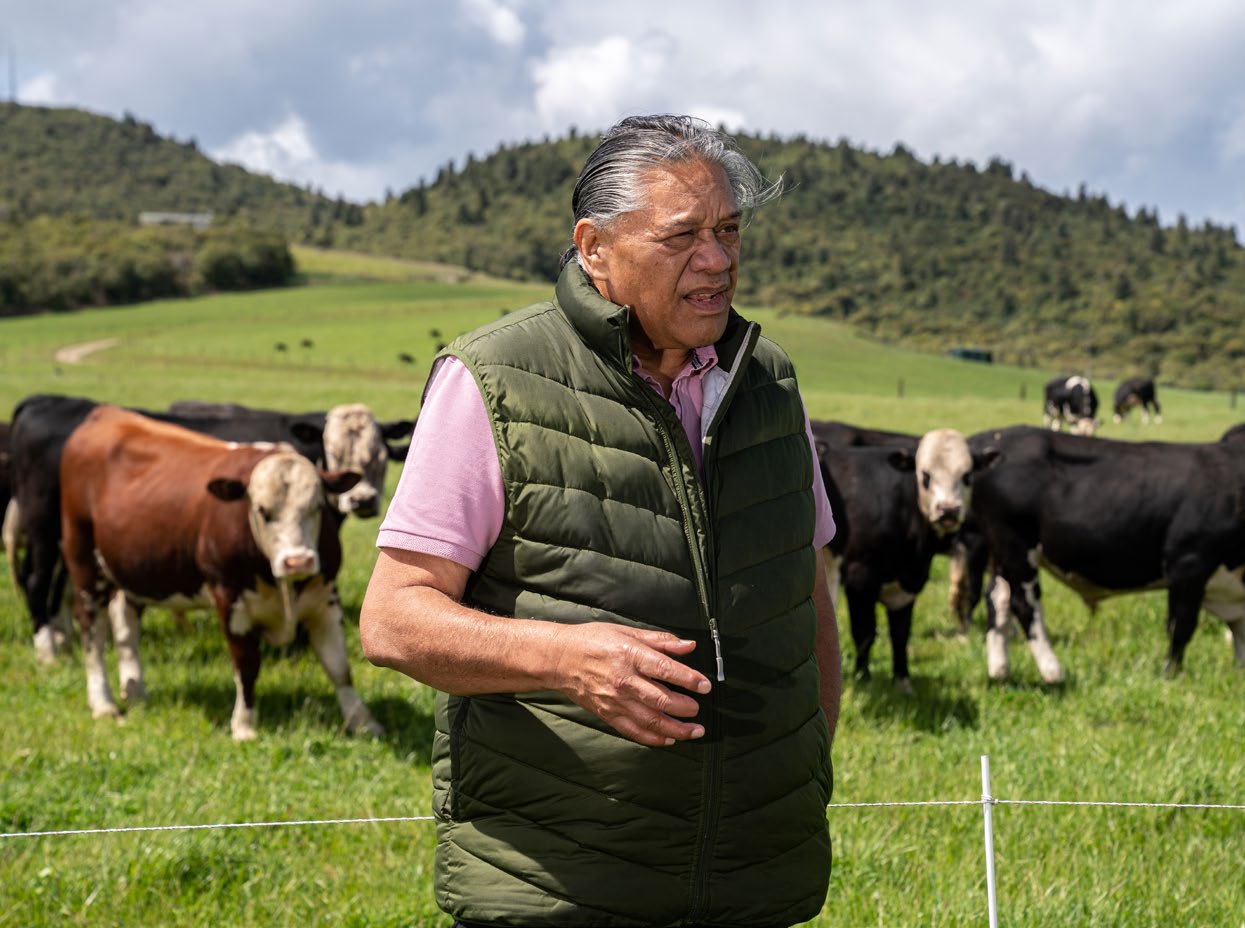
Wiari Rauhina. Photo: Richard Brimer.
In more than one one conversation, Wiari Ruahina made reference to the phrase “manaaki whenua, manaaki tangata”. Care for the land, care for the people. It’s an elegant philosophy that is filtering through conversations about how New Zealand will farm in the future. But to put it into practice is the challenge that all farmers now face.
When I asked Frank Griffin if he was hopeful New Zealand’s farmers would embrace the environmental practices embedded in the government’s regulations, he said that we’ll need all the rules to get started. But he’s confident the sector is capable of major change. “In the background, farmers are the most incredibly creative and sensitive bunch of people,” he says. “They just need some assurance.” Assurance that changing the way they farm won’t result in the end of the farm.
Nicola Harvey is a writer and audio producer. She lives on a farm north of Taupo and is working on a book about the future of food for Scribe Melbourne.
This story appeared in the December 2021 issue of North & South.
